What did the U.S. know about the Holocaust and when did we know it?
The new Ken Burns documentary offers some disturbing revelations about the darkest moments in 20th century history
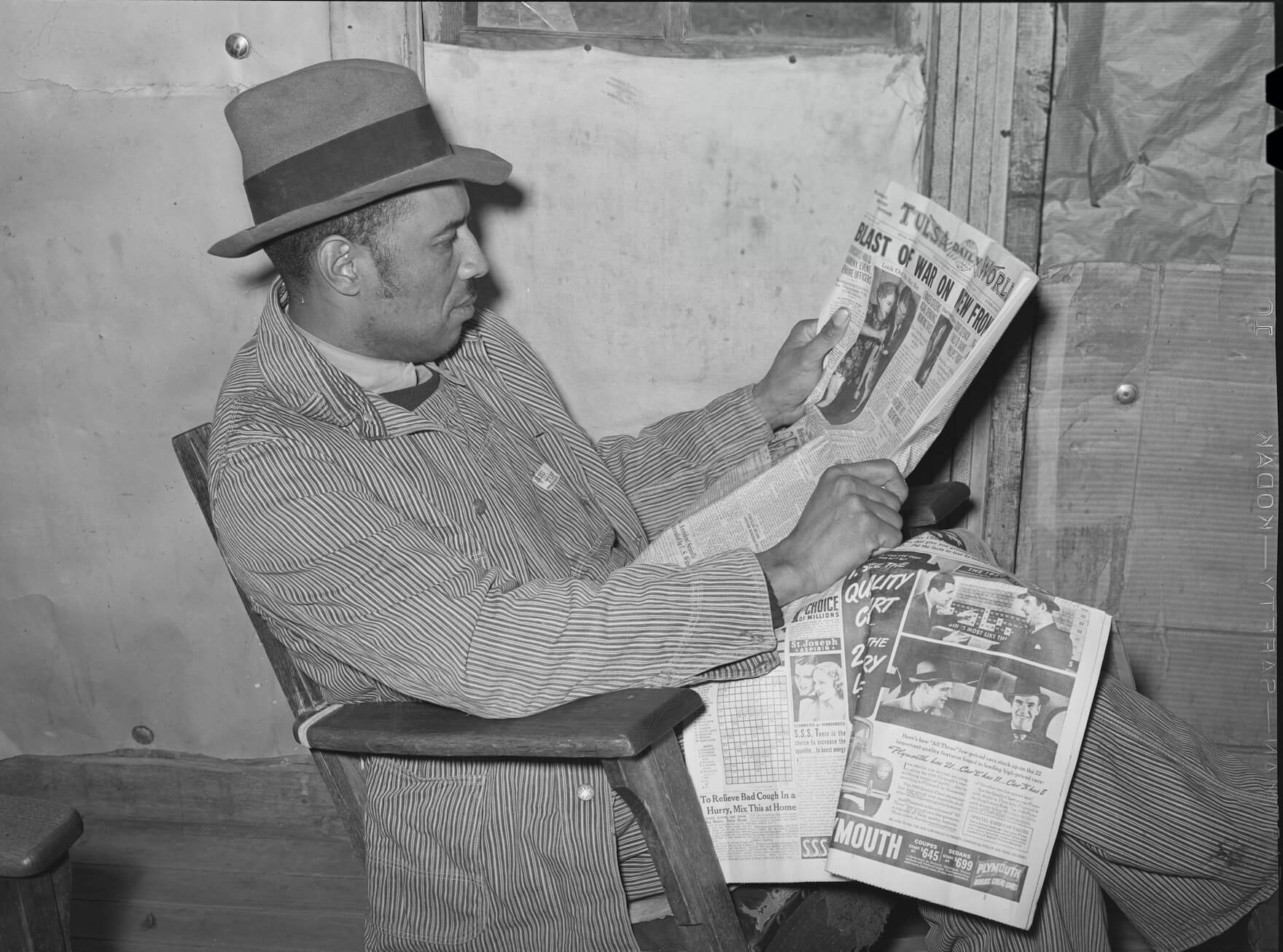
An Oklahoma farmer reads a newspaper. Courtesy of Library of Congress
In every generation, America struggles to explain itself as a nation. In “The U.S. and the Holocaust,” Ken Burns, Lynn Novick and Sarah Botstein provide an insight into the horrors of the 20th century, how America related to them at the time and how it should relate to them now.
Over three episodes, lasting six hours, the team tells the story of a major economic power and developed country that believed in its manifest destiny to conquer and colonize a continent. Its ideology stretched to transporting and slaughtering those it deemed degenerate while segregating or subjugating those it deemed merely subservient. The genocide of the former and the socially engineered cull of the latter, the leaders believed, would be forgotten, overlooked or seen as necessary for progress as the state marched from one success to the next.
Early on in this extensive documentary, “The U.S. and the Holocaust” explains how American history inspired Hitler and the Nazi regime. The nascent Third Reich embraced and distilled American ideas of social Darwinism and eugenics, Western expansion, Native American genocide, Jim Crow segregation and American antisemitism. Though we generally understand the Allies to be the “good guys” of World War II, it took only a little distillation and redirection of ideas from America and Western Europe to motivate Germany’s Eastward expansion, Jewish genocide, Slav enslavement and the creation of a Nazi-occupied Europe to parallel United States-occupied North America.
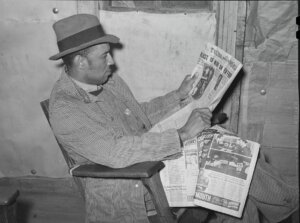
Those hoping for another documentary answering “What did Americans know?” and “Did Roosevelt do enough to save the Jews?” will be adequately satisfied. Though the subjects are not conclusively closed, the topics are deliberated from various points of view and addressed. Spoiler alert: They knew a lot, though it was hard to believe. The State Department was reprehensible, full of antisemites and small-minded racists; on the other hand, the War Refugee Board, belatedly set up and funded in January 1944 to carry out the official American policy of rescue and relief, was an agile, creative organization that saved tens of thousands of lives.
Occasionally ponderous and self-importantly explanatory in previous productions, the Ken Burns style is well suited to this self-evidently crucial topic. Though explained from many perspectives, the lens of America’s response keeps the Holocaust coverage relatively succinct. Though complex, American history, World War II and President Roosevelt’s legacy are all topics that the team has covered before. But Burns, Novick and Botstein see their remit as not only investigative and historical, but as vital, fresh and relevant.
The series title “The U.S. and the Holocaust” refers not just to 20th century United States, but, as Burns himself averred when I spoke to him for an interview, to “us” in 2022 America and the Holocaust. In today’s America, ignorance of history and the world around us can combine with racism, intolerance and the belief in charismatic charlatans to leave us open to some repeat of last century’s errors.
For example, today there are more displaced people globally than citizens of England and Spain combined. But even this mass displacement and outrage at the events in Ukraine, Afghanistan and Central America can barely provoke emergency legislation in Congress, never mind reform U.S. refugee law. It is sobering to realize that our current situation is relatively enlightened in U.S. history, with a system of refugee support (however meager) in place and, even after President Trump’s anti-immigrant regime, an average of over 70,000 immigrants arriving in the U.S. annually for the past 40 years.
By the end of the war, when the American population knew about the Holocaust and the horrors of Occupied Europe, only 5% thought that the U.S. should expand its immigration quotas from the extreme constraints of the interwar years. About a third of Americans thought that immigration should be reduced further than prewar national quotas that had excluded all Chinese, most Asians and all but a fraction of the murdered Jews of Europe.
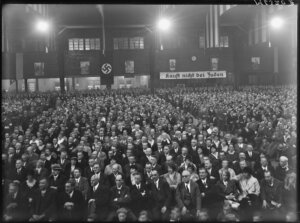
In the brutal and bloody 20th century, tens of millions had to die for those invested in the state’s racist ideology to see the error of their ways. And, as the series shows, by no means have those lessons been fully learned by 2022’s population. The final hour of the gripping production begins with a caution. There always has been and still is a dangerously large segment of the American population that believes that the so-called “white” race has a right to the American continent.
So, when Pearl Harbor finally forced the U.S. to take sides, that continent had to confront not only a formidable military opponent, but an ideology that was an ugly reflection of its own. American eugenics had taken its early ideas from Britain, but non-consensual sterilization targeting mostly Black and institutionalized people and mentally disabled women was law in 34 states. How could U.S. diplomats vilify German rules segregating Jews and gentiles when Jim Crow was still on the statute books? How could “democracies” question a sovereign nation’s right to transport out its Jewish undesirables, when — as was made clear at the 1938 Evian Conference where 32 countries gathered to discuss helping and largely decided to withhold help — none was prepared to take in Jews from German-occupied territories?
Of course, in order to explain the U.S. involvement in, and response to, the Holocaust, the series must explain the Holocaust. With a mixture of contemporary footage and current-day analysis, the series hits most of the main points of Hitler’s rise. The importance of doing this cannot be understated for a country where a recent survey showed that nearly two-thirds of millennials and Gen Z don’t know that over 6 million Jews were murdered in the Holocaust, let alone that those numbers constituted roughly two thirds of European Jewry.
As John A. Tures, professor of political science at LaGrange College, pointed out in these pages, “Most shockingly, a little over 10% of those between the ages of 18 and 40 believed that Jews were actually the perpetrators of the Holocaust.”
Particularly compelling among the many interviewees is Daniel Mendelsohn, author of “The Lost: A Search for Six of Six Million,“ an account of his investigations into “exactly, specifically, what happened” to the Polish side of his family during the Holocaust. In the documentary, a number of experts describe in either personal or historical terms what happened. Mendelsohn does both, explicitly noting the different layers of the Holocaust. As well as those millions gassed and burnt in the infamous gas chambers and crematoria, there was the “Holocaust by bullets,” ad hoc killings — for example, villagers locked in burning barns and systematic cullings through deliberate starvation, overwork and exposure to disease and the elements.
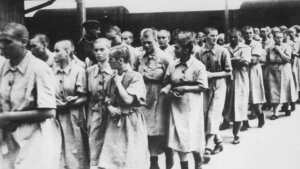
In February 1939, the virulently antisemitic German American Bund held a 20,000-strong rally in Madison Square Garden. American Nazis like these continued to protest that Nazi values were not only compatible with American values but, as they hoped to show by saluting a massive poster of George Washington, a logical extension of those values. Today, it is at MAGA or white supremacist “alt-right” rallies where you will find American Nazi sympathizers. Just like the 1939 antisemitic Bundists, Robert Packer — wearing a “Camp Auschwitz” sweatshirt — conflated Nazi values with American values as he joined in the failed Jan. 6 insurrection in Washington.
Burns and his team are not interested in allocating blame, but rather in uncovering the multiple viewpoints that detail the relation between the United States and the Holocaust. American responses stretched beyond simple legislation or executive action in reaction to facts. The scale of the events and the contexts of both the war and American public isolationist sentiment meant that nothing was simple. Even reception of facts was fraught. When Felix Frankfurter, the Jewish Supreme Court justice, was presented with private testimony about Auschwitz he expressed disbelief at the messenger’s account. “I am not saying that he is lying. I only said that I cannot believe him, and there is a difference.”
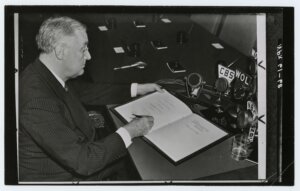
In the aftermath of the racist Trump presidency, the Holocaust is a hot topic. Between states rushing to mandate (and fund) Holocaust education, Dana Bash and Wolf Blitzer both airing specials about their families’ Holocaust experience on CNN, the recently released novel by Santiago Amigorena and forthcoming book by Jonathan Freedland on the men who escaped from Auschwitz, there is a palpable realization that we forget human inhumanity at our cost. Ignorance is real and dangerous. Massive online platforms amplify hate and misinformation for profit. Facebook and Twitter have lax rules on antisemitism which they don’t even enforce. As Sacha Baron Cohen, with whom I have worked on other projects, said at the ADL just a few years ago, “Just think what Goebbels would have done with Facebook … they’d have let Hitler buy ads.”
The vulnerability of contemporary society to “othering” as a result of racist and political lies is clearly uppermost in the filmmakers’ minds. as their production comes to air. Burns emphasized when talking to the Forward: “There’s a moment in the film where the great holocaust scholar Deborah Lipstadt says ‘the time to stop a genocide is before it happens.’ I would add that the time to save a democracy is before it’s lost.”
















